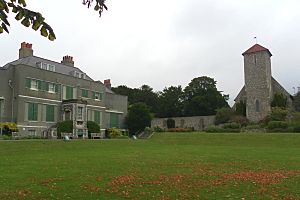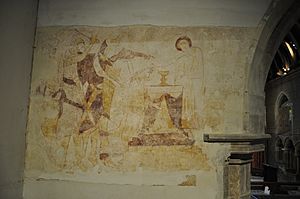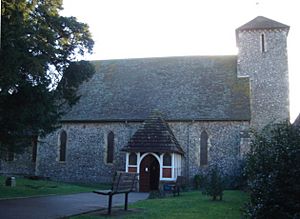St Peter's Church, Preston Village facts for kids
Quick facts for kids St Peter's Church |
|
|---|---|

The church from the northwest
|
|
| 50°50′32″N 0°08′58″W / 50.8423°N 0.1495°W | |
| Location | Grounds of Preston Manor, Preston Drove, Preston, Brighton and Hove |
| Country | England |
| Denomination | Anglican |
| History | |
| Status | Former parish church |
| Dedication | Saint Peter |
| Architecture | |
| Functional status | Redundant |
| Heritage designation | Grade II* listed |
| Designated | 13 October 1952 |
| Style | Early English |
| Closed | 1988 |
St Peter's Church is a very old church located in Preston Village, Brighton, England. It was built in the 1200s, making it over 700 years old! This church stands where two even older churches used to be.
Over the years, it was repaired and updated, especially after a big fire in 1906. St Peter's was once the main church for Preston. However, in 1908, a new church called St John the Evangelist's Church took over that role.
St Peter's Church stopped holding regular services in 1988. It is now looked after by the Churches Conservation Trust. This trust helps protect important old churches. St Peter's is also a "Grade II* listed building," which means it's a very important historical and architectural site.
Contents
History of St Peter's Church
The village of Preston was first settled a long time ago, even before the Domesday Book was written in 1086. Back then, it was called Prestetone. It had a church, a mill, and about 50 people living there. The land was owned by the Bishop of Chichester.
The church mentioned in the Domesday Book was replaced in the mid-1200s. This new church is the one we see today. It was the third church built on this spot, which is now inside the grounds of Preston Manor.
The church had a chancel (the area around the altar), a nave (the main part where people sit), and a tower at the west end. The tower had a special roof shape called a Sussex Cap. Inside, the church had amazing wall paintings from the 1200s and 1300s. These paintings showed scenes like the birth of Jesus and Saint Michael weighing souls. They also showed the story of Thomas Becket and other saints.
During the English Reformation (a time of big changes in the church), these paintings were covered with plaster. They were rediscovered in 1830 by the vicar, Reverend Charles Townsend.

In 1872, the church was repaired and made bigger by an architect named James Woodman. He added a porch and a vestry (a room for the clergy). Some people felt that the nave was "over-restored," meaning too much was changed. In 1878, another architect, Ewan Christian, updated the chancel.
By the late 1800s, Preston village was growing very fast. More people were moving in because of a new railway station and new houses being built. The church was only about 50 feet long and 26 feet wide. It could only hold 250 people, which wasn't enough for the growing population.
Church leaders wanted to make the church bigger. However, many people worried that making it larger would damage its old medieval look and disturb old memorials. So, in 1901, a new church was planned instead. St John the Evangelist's Church opened in 1902 and could hold 800 people. Even so, St Peter's Church remained the official parish church for a few more years.
On June 23, 1906, a serious fire badly damaged St Peter's Church. The beautiful wall paintings were hit especially hard. Only small parts of the Nativity, St Michael, and Thomas Becket scenes survived. The rest were destroyed.
The nave, which was the most damaged, was repaired between 1906 and 1907. However, the next year, St Peter's officially lost its status as the main parish church to St John the Evangelist's. Services continued at St Peter's until 1988. On June 1, 1990, it was officially closed and given to the Churches Conservation Trust. The Trust opens the church to visitors every day. You can also rent the church for concerts or art shows.
St Peter's Church was given "Grade II* listed" status on October 13, 1952. This means it's a very important historic building. As of 2001, it was one of 70 such buildings in Brighton and Hove.
Architecture of St Peter's Church
St Peter's Church is built from flint stones with stone details. It has a tiled roof. The church stands in a noticeable spot next to Preston Manor, on higher ground than the rest of Preston. It was built in the Early English style. This style often features tall, narrow windows.
The church has several broad lancet windows, which are tall and narrow. There are three on each side of the nave and also in the chancel. Most of these windows have been repaired over time. The tower at the west end is narrow and not very tall. It has small lancet windows and holds three bells. One of these bells might be from the 1400s!
Today, the church has a chancel with a rounded ceiling, a nave without side aisles, and a vestry with a fancy chimney. It also has a timber-framed porch with a hipped roof. When Ewan Christian renovated the church in 1878, he added beautifully carved choir stalls. One carving even shows a Native American. Inside, you can also find memorial tablets and stained glass windows that remember members of the Stanford family. A reredos (a decorated screen behind the altar) was added after the 1907 repairs. The altar itself is made from a table-tomb, which is the burial place of Edward Eldrington, a lord of Preston Manor who died in 1515.
Burials and Memorials

The church contains a memorial stone for Theodosia Meade, Countess of Clanwilliam.
See also
- Grade II* listed buildings in Brighton and Hove
- List of churches preserved by the Churches Conservation Trust in Southeast England
- List of places of worship in Brighton and Hove



